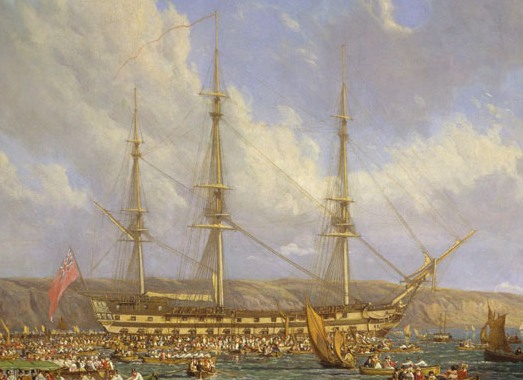I picked up a collection of Alexis de Tocqueville's notebooks from his travels in America in the 1830s recently. De Tocqueville is famous for his Democracy in America, published 1835. Part of his travels led him to board a steamer from Buffalo to Detroit, and it stopped at the town of Cleveland along the way:
21st July
Quarrel with the captain. Arrival at Cleveland at 6 o'clock in the evening. Up to there the aspect of the lake had been uniform. Generally to the right the lake, like a sea, stretched its transparent waters to the horizon. We hugged close to the shore of Pennsylvania and and Ohio on the left. That side, generally quite flat and sometimes a few feet high, was almost everywhere covered in primeval forest whose immense trees were reflected in the waters that bathed their roots. The very uniformity of the sight is impressive. One is tempted to think that the ship that bears one is the only one to trace a furrow in the waters of the lake and that the land one sees has not yet fallen under man's dominion. But that is all nothing. After coasting along for hours beside a dark forest that only ends where the lake begins, one suddenly sees a church tower, elegant houses, fine villages, with an appearance of wealth and industry. Nothing but nature is savage here; man fights against her everywhere armed with all the resources of civilization. One goes without transition from the wilds into a city street, from the most savage scenes to the most smiling pictures of civilized life. If you are not caught by nightfall and forced to lodge at the foot of a tree, you are sure to come to a place where you will find everything, even French fashions and Palais Royal caricatures.
At 7 o'clock we left Cleveland. Lovely night. The moon lighting the forest and reflected in the waters of the lake.
De Tocqueville often dwelled on Ohio in his notebooks, because it was conveniently juxtaposed against the slave state of Kentucky. He and many of the people from both states whom he interviewed stated that Ohio was characterized by industriousness and growth, whereas in Kentucky and many of the other slave states life had a more languid character. This was on account of the free labor provided by slaves, which many contemporary writers believed made the slave owners lazy.
There was a dark side to the land north of the Ohio River, though. De Tocqueville noted the strict anti-Black laws in Ohio, which required all free blacks to put up a bond as a guarantee against their legitimacy. Apparently, many white people in Ohio feared an influx of poor, unskilled former slaves or runaways who would become a burden on the state.
Mr. Walker, a young lawyer from Ohio, explained the laws to de Tocqueville:
Q. In Ohio you have made very severe laws against the blacks.
A. Yes. We try and discourage them in every possible way. Not only have we made laws allowing them to be expelled at will, but we hamper them in a thousand ways. A Negro has no political rights; he cannot be a juror; he cannot give evidence against a white. That last law sometimes leads to revolting injustices. The other day I was consulted by a Negro who had supplied a lot of victuals to the master of a steamboat. The white denied the debt. As the creditor was black, and as all his assistants were the same and so could not give evidence on his behalf as they could not appear in court, there was no way of even starting a case.
There are many such interesting notes and conversations recorded in the volume. De Tocqueville, as an outsider, uses a lot of generalizations to describe the American society he encounters, but we also get a valuable glimpse of a vanished world to which we, too, are outsiders.
The book is Alexis de Tocqueville: Journey to America (New Haven: Yale University Press, 1960).



































































